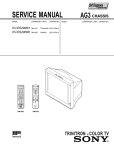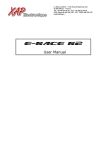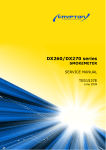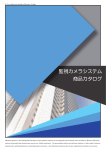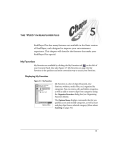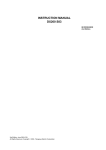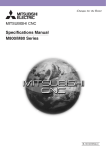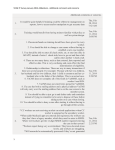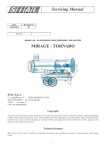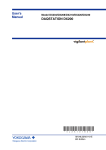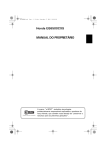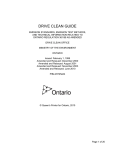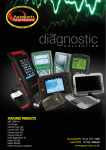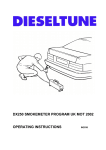Download Application Guidelines - Environmental Protection Department
Transcript
Environmental Protection Department, The Government of the Hong Kong SAR Application Guideline s for Approval for a Particulate Reduction Device for Pre-Euro Diesel Vehicles 1. Introduction 1.1 These Guidelines should be read by persons who intend to seek the approval of the Director of Environmental Protection (the “Director”) for a Particulate Reduction Device pursuant to the Air Pollution Control (Emission Reduction Devices for Vehicles) Regulation (the “Regulation”) . This document provides information on the technical requirements of an approved Particulate Reduction Device, documents to be submitted, application procedures and other relevant informatio n. Applicants should read through these guidelines and seek clarification if necessary before submitting applications. 2. The Regulation 2.1 The Air Pollution Control (Emission Reduction Devices for Vehicles) Regulation came into effect on 1st December 2003 requiring pre-Euro light diesel vehicles (i.e. those weighing up to 4 tonnes) to install with approved emission reduction devices after we had completed a voluntary programme to assist vehicle owners to install particulate reduction devices. 2.2 Between 2002 and 2004, we completed a similar voluntary retrofitting programme for pre-Euro heavy diesel vehicles weighing more than 4 tonnes, except vehicles registered with certain body types 1 . In line with pre-Euro light diesel vehicles, pre-Euro heavy diesel vehicles, except vehicles with certain body types, are required to install with approved emission reduction devices from 1st April 2006. 2.3 In 2005, we completed a voluntary retrofitting programme for non-cross boundary pre-Euro heavy diesel vehicles registered as concrete mixer, gully emptier, lorry crane or pressure tanker. About 95% of about 2,700 of these types of pre-Euro heavy diesel vehicles participated in the programme. From 1st April 2007, this category of vehicles is also required to be installed with approved emission reduction devices. 2.4 Under Section 6 of the Regulation, the Director may approve particulate reduction devices that 1 Vehicles registered with any one of the following types of body: aerial platform, concrete mixer, gully emptier, lorry crane, mobile crane, mobile concrete pump and pressure tanker. 1 meet the requirements for use in scheduled vehicles listed in Appendix A. A list of approved Particulate Reduction Devices will be placed in a register for public inspection free of charge. 3. Requirements for an Approved Particulate Reduction Device 3.1 The device seeking approval must meet all the performance specifications listed in Appendix B. 4. Application Procedure 4.1 Applicant shall fill in the application form. Copies of the form can be obtained from Environmental Protection Department, Room 4518, 45/F, Revenue Tower, No. 5 Gloucester Road, Wan Chai, Hong Kong (Telephone no: 2824 0022, Facsimile no: 2877 8690), or downloaded from the Department’s website at http://www.epd.gov.hk/epd. 4.2 One application shall be made for “each” model of particulate reduction device. The application shall be submitted by post or in person to the Director of Environmental Protection at the above mentioned address with “PRD Application” marked on the envelope. 4.3 The application form shall be accompanied with the supporting documents as listed in Appendix B to demonstrate the device’s compliance with the requirements as set out for an approved Particulate Reduction Device. Applicants are reminded that the device must be properly tested and relevant test report(s) issued by reputable laboratories. In addition, explanations should be provided in the application form for not submitting any of the documents as listed in Appendix B. 4.4 A qualified engineer shall prepare those supporting documents as listed in Appendix B and sign each of the original supporting documents he/she prepared. All emission test reports submitted must carry the certification by the laboratory manager who supervised the tests and preparation of the reports that all emission test data collected by the test laboratory and submitted, as part of the application, are accurate and complete. Test results alone or part report are not considered as proper supporting documents. 4.5 The applicant shall number all pages of the supporting documents. 4.6 Seven sets of the supporting documents as required in Appendix B shall be submitted with the application. 4.7 Applicants shall ensure that their complete applications reach the Environmental Protection Department at the address mentioned in Paragraph. 4.1 on or before the last working day of each 2 month such that the applications can be forwarded in a batch to the Panel (as mentioned in Section 5 below) in the following month. 4.8 Upon receipt of a complete set of application, an acknowledgment letter will be sent to the applicant. 4.9 The application is free of charge. 5. Assessment and Notifications 5.1 The Director of Environmental Protection has set up an independent panel of experts (the “Panel”) to assess the applications and advise him on the device’s compliance with the performance specifications listed in Appendix B. Information on the Panel can be viewed from the Environmental Protection Department or from the Department’s website at the address given in Paragraph 4.1. 5.2 Due to the amount of technical information involved, the Panel normally requires two months to complete the assessment of a batch of applications and provide their advice to the Director. Under normal circumstances, the Director will be able to inform the applicant of the outcome of the assessment of the performance specifications listed in Appendix B within three months from the receipt of the application. However, the process may take longer if the Director needs to further consider the application. 5.3 The Panel will assess the application based entirely on the information submitted. If the Panel considered the applicant failed to provide sufficient information in the application to demonstrate the device’s compliance with the requirements in Appendix B, the application will be rejected. For such a case, the applicant may consider submitting a fresh application for the same device to provide new or further information at any time. 6. Amendments and Alterations 6.1 The successful applicant sha ll seek prior approval from the Director regarding any alteration or modification of an approved Particulate Reduction Device and provide photos, dimensioned drawings and any relevant information regarding any changes in the manufacturing or appearance of the approved device before the sale of these devices. Once changes were made to an approved Particulate Reduction Device without the prior approval of the Director, its approval shall become void automatically. 3 7. Other Requirements Installation Specifications 7.1 The installation of an approved device shall follow the installation guidelines as set out in Appendix E. The applicant shall provide every customer with detailed installation instructions for each of the device sold. The Director of Environmental Protection may delete an approved emission reduction device from the register if the applicant failed to meet this requirement. Advertisement and Publicity 7.2 The applicant shall submit to the Director for consent all advertisement or other publicity material relating to the Particulate Reduction Device in connection with the Government’s name is mentioned or language used for which a connection with the Government can reasonably be inferred or implied. The application shall not publish or use any suc h advertising or other publicity material without the prior written consent of the Government. The Director may delete an approved emission reduction device from the register if the applicant failed to meet this requirement. 7.3 The Government has absolute discretion to refuse consent without any reason being given and the applicant is not entitled to make any claim against the Government. 7.4 Any device which fails to obtain approval of the Director must not be sold as an “Approved” Particulate Reduction Device. Register of Approved Device 7.5 Under section 5(2) of the Regulation, the Director of Environmental Protection shall keep a register of approved devices containing the following details : (a) the brand name; (b) the model; (c) the applicability of the device; and (d) other information for the purposes of the Regulation. 7.6 The successful applicant shall provide the information required in Paragraph 7.5 for the register. 4 8. Appeal 8.1 In the case of any unsuccessful application, the applicant may consider submitting a fresh application for the same device at any time with additional or new information to demonstrate the Device’s compliance with the requirements for an approved Device. 8.2 A right of appeal is provided under section 31(1)(s) of the Air Pollution Control Ordinance. The applicant may lodge an appeal against the decision made by the Director on the approval of the application to the Air Pollution Control Appeal Board within 21 days upon receipt of the notice of the decision. For further information about the appeal procedures and the Regulation on the Appeal Board, you may contact the Secretary of the Air Pollution Appeal Board, Executive Officer (CBD), Environmental Protection Department, 40/F., Revenue Tower, 5, Gloucester Road, Wanchai, Hong Kong. (Telephone No. 2594 6324, Fax No. 2872 0603). 9. Enquiries 9.1 Enquiries concerning the application for approval of particulate reduction device may be made to the Mobile Source Control Group of the Environmental Protection Department at the following address: Address Room 4518, 45/F Revenue Tower, 5 Gloucester Road, Wan Chai, Hong Kong Telephone 2824 0022 5 Facsimile 2877 8690 Appendix A Schedule 1 of Air Pollution Control (Emission Reduction Devices for Vehicles) Regulation Scheduled Vehicles Effective from 1st December 2003 Category (1) A private car, goods vehicle or light bus which – (a) is equipped with a compression- ignition engine; (b) is licensed under the Road Traffic (Registration and Licensing of Vehicles) Regulations; (c) has a permitted gross vehicle weight of not more than 4 tonnes; and (d) was first registered on or before 31 March 1995. Category (2) A taxi which – (a) is equipped with a compression- ignition engine; (b) is licensed under the Road Traffic (Registration and Licensing of Vehicles) Regulations; and (c) was first registered on or before 31 December 1995. Effective from 1st April 2006 Category (3) A light bus which – (a) is equipped with a compression- ignition engine; (b) is licensed under the Road Traffic (Registration and Licensing of Vehicles) Regulations; (c) has a permitted gross vehicle weight of over 4 tonnes; and (d) was first registered on or before 31 March 1995. Category (4) A bus which(a) is equipped with a compression- ignition engine; (b) is licensed under the Road Traffic (Registration and Licensing of Vehicles) Regulations (Cap. 374 sub. leg. E), and (c) was first registered on or before 31 March 1995. Category (5) A goods vehicle which (a) is equipped with a compression- ignition engine; (b) is licensed under the Road Traffic (Registration and Licensing of Vehicles) Regulations (Cap. 374 sub. leg. E); (c) has a permitted gross vehicle weight of more than 4 tonnes; and (d) was first registered on or before 31 March 1995, but does not belong to any of the following types of body as shown in the registration document: (i) aerial platform; (ii) concrete mixer; 6 (iii) (iv) (v) (vi) (vii) gully emp tier; lorry crane; mobile crane; mobile concrete pump; and pressure tanker.” Effective from 1st April 2007 Category (6) A goods vehicle which (a) is equipped with a compression-ignition engine; (e) is licensed under the Road Traffic (Registration and Licensing of Vehicles) Regulations (Cap. 374 sub. leg. E); (f) has a permitted gross vehicle weight of more than 4 tonnes; (g) was first registered on or before 31 March 1995, and (h) belong to any of the following types of body as shown in the registration document: (i) concrete mixer; (ii) gully emptier; (iii) lorry crane; and (iv) pressure tanker does not meet any of the following condition – (v) a specified road permit issued in respect of the vehicle is in force; (vi) a specified road permit issued in respect of the vehicle expired in the last 3 months. [“Specified road permit” means a closed road permit issued – (a) by the Commissioner for Transport under regulation 49 of the Road Traffic (Registration and Licensing of Vehicles) Regulations (Cap. 372 sub. leg.E); and (b) to a person who wishes to drive a motor vehicle, or wishes a motor vehicle to be driven, out of Hong Kong through a closed road.] 7 Appendix B Performance Specifications for an Approved Particulate Reduction Device for Scheduled Vehicles listed in Appendix A and the list of Supporting Documents required for the application (1) For Vehicle Categories 1 and 2 in Appendix A Ÿ Performance Specifications B.1 The Particulate Reduction Device shall be designed based on sound and proven scientific principle. B.2 It shall be an add-on device that can remove/reduce the particulate matters in the exhaust of a scheduled vehicle. B.3 During operation of the Particulate Reduction Device or the engine of a scheduled vehicle which it is installed, its substantial part, whether in its original or any transformed physical or chemical states, shall not be expelled out of the vehicle engine. B.4 The Particulate Reduction Device shall not require any fuel-additive to support its operation. Nor shall it be an additive, by itself, for consumption in the combustion process of the engine. B.5 The Particulate Reduction Device shall be able to remove at least 30% of the particulate matters in the exhaust of scheduled vehicles with no increase in emissions of other pollutants under local fuel pattern. B.6 The Particulate Reduction Device shall be able to operate unattended under local driving conditions continuously for a minimum of 12 hours with no loss to its particulate capture capability. B.7 The release of particulate captured in the Particulate Reduction Device shall not be more than 50% under any operating condition of the vehicle. B.8 The Particulate Reduction Device shall not cause harmful effects on the engine of a scheduled vehicle in which it is installed and affect the performance of the engine. B.9 The Particulate Reduction Device is suitable for local use. B.10 The Particulate Reduction Device shall be designed and constructed to allow smoke measurement be made without dismantling it from a scheduled vehicle. 8 Ÿ Supporting Documents The application shall be accompanied with the following documents to demonstrate the device under application complies in full with the environmental performance specifications for an Approved Particulate Reduction Device for vehicle categories 1 and 2: B.11 Technical papers and references that substantiate the design and operation principle of the device. B.12 Details of the construction of the device, including type of construction materials, fully dimensioned drawings and mounting details. B.13 Colour photos, product brochures and commercial promotional packages of the device. B.14 Test report(s): (a) to demonstrate that the device has a particulate reduction efficiency of 30% or better and no increase in emissions of other air pollutants from the exhaust of the scheduled vehicles it is installed. The test must follow the ECE R49 13- mode Test Cycle or suitable emission certification cycles of equivalent stringency and with local fuel pattern. (b) to indicate the level of particulate loading capacity for 12 hours unattended operation of the device and that the release of the stored particulate (after the aforementioned operational 12 hours), if any, is less than 50% during a full power lug down test. (c) to show the device is compatible with the different types of scheduled vehicles (with data such as engine power, exhaust temperature and exhaust back pressure, etc.). B.15 The tests shall be carried out by an independent third party laboratory either (i) accredited according to EN 45 001 (alternatively certified according to ISO 17 025), or (ii) certified according to ISO 9000/ISO 14000, or (iii) included on the list of laboratories capable of testing diesel vehicle as listed on (a) the US Environmental Protection Agency web site http://www.epa.gov/otaq/consumer/lablist.pdf, or (b) list issued by the European Union, or (c) the California Air Resources Board. A copy of the certification, accreditation or listing should be provided. 9 B.16 For laboratories that do not fall in the scope of B.15, documentary evidence shall be provided showing that the laboratory had attained similar of equivalent competence in performing quality tests for verifications of emission performance of the device. B.17 Local or overseas trial data of the device. B.18 Drawings and photos illustrating smoke measurement can be carried out without the need of dismantling of the device. B.19 Test report to demonstrate the installation of the device will not result in any increase in noise as required under Section 30 of the Road Traffic (Construction and Maintenance of Vehicles) Regulations. B.20 Full details on the maintenance required and a list of all consumable parts of the device and their replacement frequency. B.21 Chinese and English user manual on the maintenance and cleaning of the device. (2) For Vehicle Categories 3 to 5 in Appendix A (2a) Vehicle Categories 3 to 5 - Using Diesel of Sulphur Content not more than 0.005% (by Weight) Ÿ Performance Specifications B.22 The Particulate Reduction Device shall be designed based on sound and proven scientific principle. B.23 The Particulate Reduction Device must achieve an initial particulate reduction (on a brake specific mass basis, or distance specific mass basis, depending upon the type of test being conducted) of no less than 35%. The particulate emissions reduction must be achieved under the transient test. The test fuel for all tests should never contains sulphur less than 0.005% (by weight). B.24 The Particulate Reduction Device shall not result in an increase in exhaust backpressure of more than 25 mm Hg. Furthermore, the backpressure should not exceed the upper limit given by the engine manufacturer. B.25 There should be no increase in carbon monoxide (CO), total hydrocarbons (THC), oxides of nitrogen (NOx) or other harmful emissions when testing with the device compared to testing 10 without the device beyond test-to-test variability that is accepted internationally. B.26 The Vehicle shall not cause any violation of the roadworthiness requirements under the Road Traffic Ordinance, Cap. 374 of the Government of the Hong Kong Special Administrative Region as a result of the installation of the Particulate Reduction Device. B.27 The Partic ulate Reduction Device shall be an add-on device. The Particulate Reduction Device must be designed for retrofitting in diesel vehicles without any engine modifications or engine setting changes such as timing adjustment. B.28 The Particulate Reduction Device must be maintenance free and service free over its full warranty period. No addition of additives or chemicals beyond those installed with the device will be allowed. B.29 The Particulate Reduction Device shall be suitable for local use. B.30 The Particulate Reduction Device shall be designed and constructed to allow smoke measurement be made without dismantling it. B.31 The applicant shall provide user manuals for maintaining and cleaning of the Particulate Reduction Device. The user manual shall be in Chinese as well as English. Ÿ Supporting Documents The application shall be accompanied with the following documents to demonstrate the device under application complies in full with the environmental performance specifications for an Approved Particulate Reduction Device or vehicle categories 3 to 5 in Appendix A and using diesel of sulphur content not more than 0.005% (by Weight): B.32 Technical papers and references that substantiate the design and operation principle of the device. B.33 Details of the construction of the device, including type of construction materials, fully dimensioned drawings and mounting details. B.34 Colour photos, product brochures and commercial promotional packages of the device. B.35 Test reports: (a) to demonstrate that the device has the particulate reduction percentage of the Particulate Reduction Device achieves an initial particulate reduction of no less than 11 35%. The particulate emissions reduction must be achieved under the transient test. The test fuel for all tests should never contain sulphur less than 0.005% (by weight). (b) to demonstrate the backpressure increase due to the installation of the Particulate Reduction Device will not result in an increase in exhaust backpressure of more than 25 mm Hg. (c) to demonstrate the installation of Particulate Reduction Device will not increase in CO, THC, NOx or other harmful emissions. (d) to provide analysis of test fuels used for all testing. The emission testing requirements are given in Appendix C. B.36 The tests shall be carried out by an independent third party laboratory either (i) accredited according to EN 45 001 (alternatively certified according to ISO 17 025), or (ii) certified according to ISO 9000/ISO 14000, or (iii) included on the list of laboratories capable of testing diesel vehicle as listed on (a) the US Environmental Protection Agency web site http://www.epa.gov/otaq/consumer/lablist.pdf, or (b) list issued by the European Union, or (c) the California Air Resources Board. A copy of the certification, accreditation or listing should be provided. B.37 For laboratories that do not fall in the scope of B.36, documentary evidence shall be provided showing that the laboratory had attained similar or equivalent competence in performing quality tests for verifications of emission performance of the device. B.38 Local or overseas trial data of the device. B.39 Drawings and photos illustrating smoke measurement can be carried out without the need of dismantling of the device. B.40 Test report to demonstrate the installation of the device will not result in any increase in noise as required under Section 30 of the Road Traffic (Construction and Maintenance of Vehicles) Regulations. B.41 Full details on the maintenance required and a list of all consumable parts of the device and their replacement frequency. 12 B.42 Chinese and English user manual on the maintenance and cleaning of the device. (2b) For Vehicle Categories 3 to 5 in Appendix A - Using Diesel of Sulphur Content up to 0.2% (by Weight) Ÿ Performance Specifications B.43 The Particulate Reduction Device shall be designed based on sound and proven scientific principle. B.44 The Particulate Reduction Device must achieve an initial particulate reduction (on a brake specific mass basis, or distance specific mass basis, depending upon the type of test being conducted) of no less than 25%. The particulate emissions reduction must be achieved under the transient test. The test fuel for all tests should never contain sulphur less than 0.2% (by weight). B.45 The Particulate Reduction Device shall not result in an increase in exhaust backpressure of more than 25 mm Hg. Furthermore, the backpressure should not exceed the upper limit given by the engine manufacturer. B.46 There should be no increase in carbon monoxide (CO), total hydrocarbons (THC), oxides of nitrogen (NOx) or other harmful emissions when testing with the device compared to testing without the device beyond test-to-test variability that is accepted internationally. B.47 The Vehicle shall not cause any violation of the roadworthiness requirements under the Road Traffic Ordinance, Cap. 374 of the Government of the Hong Kong Special Administrative Region as a result of the installation of the Particulate Reduction Device. B.48 The Particulate Reduction Device shall be an add-on device. The Particulate Reduction Device must be designed for retrofitting in diesel vehicles without any engine modifications or engine setting changes such as timing adjustment. B.49 The Particulate Reduction Device must be maintenance free and service free over its full warranty period. No addition of additives or chemicals beyond those installed with the device will be allowed. B.50 The Particulate Reduction Device shall be suitable for local use and with cross boundary operation. 13 B.51 The Particulate Reduction Device shall be designed and constructed to allow smoke measurement be made without dismantling it. B.52 The applicant shall provide user manuals for maintaining and cleaning of the Particulate Reduction Device. The user manual shall be in Chinese as well as English. Ÿ Supporting Documents The application shall be accompanied with the following documents to demonstrate the device under application complies in full with the environmental performance specifications for an Approved Particulate Reduction Device for vehicle categories 3 to 5 in Appendix A using diesel of sulphur content up to 0.2% (by Weight): B.53 Technical papers and references that substantiate the design and operation principle of the device. B.54 Details of the construction of the device, including type of construction materials, fully dimensioned drawings and mounting details. B.55 Colour photos, product brochures and commercial promotional packages of the device. B.56 Test reports: (a) to demonstrate that the device has the particulate reduction percentage of the Particulate Reduction Device achieves an initial particulate reduction of no less than 25%. The particulate emissions reduction must be achieved under the transient test. The test fuel for all tests should never contain sulphur less than 0.2% (by weight). (b) to demonstrate the backpressure increase due to the installation of the Particulate Reduction Device will not result in an increase in exhaust backpressure of more than 25 mm Hg. (c) to demonstrate the installation of Particulate Reduction Device will not increase in CO, THC, NOx or other harmful emissions. (d) to provide analysis of test fuels used for all testing. The emission testing requirements are given in Appendix C. 14 B.57 The tests shall be carried out by an independent third party laboratory either (i) accredited according to EN 45 001 (alternatively certified according to ISO 17 025), or (ii) certified according to ISO 9000/ISO 14000, or (iii) included on the list of laboratories capable of testing diesel vehicle as listed on (a) the US Environmental Protection Agency web site http://www.epa.gov/otaq/consumer/lablist.pdf, or (b) list issued by the European Union, or (c) the California Air Resources Board. A copy of the certification, accreditation or listing should be provided. B.58 For laboratories that do not fall in the scope of B.57, documentary evidence shall be provided showing that the laboratory had attained similar or equivalent competence in performing quality tests for verifications of emission performance of the device. B.59 Local or overseas trial data of the device. B.60 Drawings and photos illustrating smoke measurement can be carried out without the need of dismantling of the device. B.61 Test report to demonstrate the installation of the device will not result in any increase in noise as required under Section 30 of the Road Traffic (Construction and Maintenance of Vehicles) Regulations. B.62 Full details on the maintenance required and a list of all consumable parts of the device and their replacement frequency. B.63 Chinese and English user manual on the maintenance and cleaning of the device. (3) For Vehicle Category 6 in Appendix A – Using Diesel of Sulphur Content not more than 0.005% (by Weight) The purpose of the installation of an approved particulate reduction device is to reduce particulate emissions and emissions of white smoke from Pre-Euro emission standard 2 diesel engines in vehicles over 4 tonnes using typical Hong Kong diesel fuel under regularly long idle operating 2 A pre-Euro emission standard engine is an engine certified to emission standard more lenient than Euro I emission standard (91/542/EEC). US certified pre 1990 engines would be considered equivalent to pre-Euro emission standard engines. 15 conditions (i.e. vehicles registered types of body as concrete mixer, gully emptier, lorry crane or pressure tanker). This specification is dealing with the reduction of white smoke after long idling time and is a supplement to the specification for reduction of particulate matter. Ÿ Performance Specifications B.64 The Particulate Reduction Device shall be designed based on sound and proven scientific principle. B.65 The Particulate Reduction Device must achieve an initial particulate reduction (on a brake specific mass basis, during the prescribed test procedure (Paragraph D.7 in Appendix D) of no less than 35%. The particulate emissions reduction must be achieved under the transient test. The test fuel for all tests should never contain sulphur less than 0.004% (by weight). B.66 The Particulate Reduction Device shall in addition to B.65 also be designed in such a way that white smoke coming out from the tailpipe is minimized. The performances to be fulfilled are: (i) During the prescribed test procedure (see Paragraph D.8 in Appendix D), the value of total hydrocarbons (THC) measured after the device may not exceed 150 ppm (parts per million) at any time (peak level), and smoke level3 may not exceed 50 Hartridge Smoke Units (HSU); and (ii) The difference in average THC, measured after initial conditioning (see Paragraph D.8.3 in Appendix D) and the post idling conditioning (see Paragraph D.8.5 in Appendix D) may not be differ by more than ±15% and not exceed 50 ppm. B.67 The Particulate Reduction Device shall not result in an increase in exhaust backpressure of more than 25 mm Hg. Furthermore, the backpressure should not exceed the upper limit given by the engine manufacturer. B.68 There should be no increase in carbon monoxide (CO), total hydrocarbons (THC) (with the exception of the verification of absence of white smoke test as stated in Paragraph D.8 in Appendix D), oxides of nitrogen (NOx), smoke or other harmful emissions when testing with the particulate reduction device compared to testing without the particulate reduction device beyond test-to-test variability that is accepted internationally. B.69 The Particulate Reduction Device or its installation shall not cause the Vehicle any violation 3 The smoke level should be measured by means of any one of the apparatus specified by the Commissioner for Transport by notice published in the Gazette No. 44, Vol. 4, Year 2000 as seen in Paragraph D.10 of Appendix D. 16 of the roadworthiness requirements under the Road Traffic Ordinance, Cap. 374 of the Government of the Hong Kong Special Administrative Region. B.70 The Particulate Reduction Device shall be an add-on device. The Particulate Reduction Device must be designed for retrofitting in diesel vehicles without any engine modifications or engine setting changes such as timing adjustment. B.71 The Particulate Reduction Device must be maintenance free and service free over its full warranty period. No addition of additives or chemicals beyond those installed with the device will be allowed. B.72 There should be no by-pass mechanism to disallow the proper functioning of the particulate reduction device any time. B.73 The Particulate Reduction Device shall be suitable for local use. B.74 The Particulate Reduction Device shall be designed and constructed to allow smoke measurement be made without dismantling it. B.75 The applicant shall provide user manuals for maintaining and cleaning of the Particulate Reduction Device. The user manual shall be in Chinese as well as English. Ÿ Supporting Documents The application shall be accompanied with the following documents to demonstrate the device under application complies in full with the environmental performance specifications for an Approved Particulate Reduction Device for long idling pre-Euro diesel vehicles using diesel of sulphur content not more than 0.004% (by Weight): B.76 Technical papers and references that substantiate the design and operation principle of the device as specified in B.64 above. B.77 Details of the construction of the device, including type of construction materials, fully dimensioned drawings and mounting details to demonstrate the particulate reduction device complies with the requirements in B.69, B.70 and B.72 above. B.78 Colour photos, product brochures and commercial promotional packages of the device. B.79 Test reports: (a) to demonstrate that the device has the particulate reduction percentage of the 17 Particulate Reduction Device achieves an initial particulate reduction of no less than 35% as specified in B.65 above. The particulate emissions reduction must be achieved under the transient test. The test fuel for all tests should never contain sulphur less than 0.004% (by weight). (b) to demonstrate that the device is designed in such a way that white smoke coming out from the tailpipe is minimized as specified in B.66 above. (c) to demonstrate the backpressure increase due to the installation of the Particulate Reduction Device will not result in an increase in exhaust backpressure of more than 25 mm Hg as specified in B.67 above. (d) to demonstrate the installation of Particulate Reduction Device will not increase in CO, THC, NOx, smoke or other harmful emissions as specified in B.68 above. (e) to provide analysis of test fuels used for all testing. The test fuels used in all testing must be of similar and consistent properties, with the sulphur content meeting the requirement stated in B.65 above. A report with analysis of the test fuels used should include total sulphur, aromatics, cetane number, viscosity, API gravity, initial boiling point, T10 and T90 points on the distillation curve of the test fuels used. The emission testing requirements are given in Appendix D. B.80 The tests shall be carried out by an independent third party laboratory either (i) accredited according to EN 45 001 (alternatively certified according to ISO 17 025), or (ii) certified according to ISO 9000/ISO 14000 recognized by European Union Authority, or the US Environmental Protection Agency or the California Air Resources Board. A copy of the certification, accreditation or listing should be provided. B.81 For laboratories that do not fall in the scope of B.80, documentary evidence shall be provided showing that the laboratory had attained similar or equivalent competence in performing quality tests for verifications of emission performance of the device. B.82 Local or overseas trial data of the device. B.83 Drawings and photos illustrating smoke measurement can be carried out without the need of dismantling of the device as specified in B.74 above. B.84 Test report to demonstrate the installation of the device will not result in any increase in 18 noise as required under Section 30 of the Road Traffic (Construction and Maintenance of Vehicles) Regulations as specified in B.69 above. B.85 Full details on the maintenance required and a list of all consumable parts of the device and their replacement frequency as specified in B.71 above. B.86 Chinese and English user manual on the maintenance and cleaning of the device. - END – 19 Appendix C Emission Testing Requirements for Vehicle Categories 3 to 5 in Appendix A Emission Testing Requirements C1. This Appendix provides directions on how each of the in- laboratory baseline tests shall be conducted. C.2 The applicant has the option of engine dynamometer testing or chassis dynamometer testing. C.3 The Particulate Reduction Device shall be tested using a combination of engine and device that is representative of those in operation in Hong Kong. The engine must be a pre-Euro emission standard engine or the vehicle must be equipped with a pre-Euro engine. The applicant shall conduct the test under a “worst-case” scenario. C.4 Engine settings should be the same with the device as without the device. Any work done to the test engine invalidates the test. C.5 The Particulate Reduction Device used in the tests shall be “broken-in” per retrofit device manufacturer’s specifications. For example, an oxidation catalytic converter shall be de-greened for at least 10 hours per established industry standards. The emission performance verification test report shall be submitted with an explanation from the manufacturer of the Emission Reduction Device as to how the de-greening/ageing was carried out. C.6 Engine Dynamometer Testing C.6.1 Brake-specific emissions of particulate, CO, THC, NOX, carbon dioxide (CO2 ) and soluble organic fraction (SOF), shall be measured using a total exhaust dilution tunnel (single or double dilution) in combination with a constant volume sampler (CVS) and reported. Engine testing must be carried out using the European Transient Cycle (ETC) or the US Federal Test Procedure (FTP) and at least two steady state modes (Modes 2 and 3 of the European Stationary Cycle, ESC). Calibrations and routine checks of all analysers, dynamometer, sensors, and CVS shall be performed following requirements in respectively US regulation or EU directive. Emissions analysis shall also be performed according to regulations or directives, respectively. C.6.2 All tests, as described below, shall be conducted first without the Particulate Reduction Device, and then with the Particulate Reduction Device connected to the engine. The connection of the Particulate Reduction Device should resemble the actual vehicle installation. The Particulate Reduction Device shall be installed in 20 accordance with the applicant’s written instructions, identical to those submitted in the application, either by the laboratory personnel or alternatively, at the applicant’s option, his own personnel but only under the careful supervision of the laboratory personnel. C.6.3 Before the test starts, the engine should be preconditioned appropriately. It is essential that the engine be preconditioned in the same way before each test. Temperature measurements before and after the device could serve as one indicator of equal conditioning. The engine (without the Particulate Reduction Device) shall be operated over the transient cycle selected (see above) and brake-specific emissions shall be determined. At least two consecutive hot start transient tests shall be conducted with and without the device and results shall be reported as an average of the two test runs. At their own option, the applicant can carry out additional tests if they so choose with the overall average considered as a result. Each hot start trans ient cycle shall be followed by a twenty (20) minute soak. C.6.4 Following the last soak of the transient test series (and prior to installing the Particulate Reduction Device on the engines), steady state tests (Modes 2 and 3) of the ESC procedure on the engine shall be conducted. Exhaust backpressure shall be set at a value that is within the engine manufacturer’s specifications. C.6.5 During steady-state tests, the engine shall be operated for a total of 10 minutes at each mode. The engine shall be allowed to stabilize during the first five minutes, and emissions data shall be collected during the remaining 5 minutes. Gaseous emissions data for CO, THC, NOX and CO2 shall be collected continuously for at least two minutes. Particulate and SOF should also be collected and reported. Alternatively, the applicant could choose to run the full ESC test in accordance with the European Directive (1999/96/EC) and report the results for particulate, CO, THC, NOx and CO2 for modes 2 and 3. C.6.6 The brake-specific emissions data that will be reported should be an average of a minimum of two steady state tests for each of the two modes. At their own option, the applicant can carry out additional tests if they so choose with the overall average considered as the result. C.6.7 Install the retrofit device on the engine and repeat steps C.6.3, C.6.4, C.6.5 and C.6.6. C.6.8 Exhaust temperatures (immediately upstream of the retrofit device as well as downstream) and exhaust backpressures shall be continuously recorded and 21 reported. The exhaust backpressures should be similar in all of the tests (respectively with and without the retrofit device) on the engine. Under no circumstance shall the backpressure exceed the engine manufacturers’ specifications; nor should backpressure increase by more than 25 mm Hg comparing tests with the device to those without the device. ALTERNATIVELY C.7. Chassis Dynamometer Testing C.7.1 Chassis dynamometer-based testing shall be performed using good engineering practices and be reported accordingly. For example, the dynamometer should be capable of incorporating inertias representing the maximum range of Gross Vehicle Weight Rating (GVWR) of vehicles for which the device will be installed and dynamometer road loads should be set appropriately. C.7.2 Vehicles shall be tested at the following inertial test weights: a. Goods Vehicle: For goods vehicle with GVWR less than or equal to 27,200 kg, the test weight shall be 70% of the GVWR. For goods vehicle with GVWR greater than 27,200 kg, the test weight should be set at a maximum of 19,100 kg. b. Buses: Test weights for buses shall be equal to the curb weight + half of the total passenger load + one driver. Weight of each passenger and driver shall be considered to be 54 kg. C.7.3 Vehicles shall be exercised over the European Braunschweig Driving Cycle (EBDC) or the US EPA Urban Dynamometer Driving Schedule (UDDS), or any other cycle of stringency as deemed equivalent, and a steady state operation at 72 km/h using test weights listed in Section C.7.2 above. Vehicles subject to any other driving scheme must demonstrate that the device under testing will achieve similar performance when tested under the UDDS or the EBDC. C.7.4 Distance-specific emissions (for example, grams/km) of particulate, CO, THC, NOx , CO2 , and SOF, shall be measured using a total exhaust dilution tunnel (single or double dilution) in combination with a CVS and reported. Calibrations and routine checks of all analysers, dynamometer, sensors and CVS shall be performed in accordance with prescribed regulation or following accepted industry procedures. Emissions analysis shall also be performed in accordance with prescribed regulation or following accepted industry procedures. 22 C.7.5 All tests, as described below, shall be cond ucted first without the Particulate Reduction Device, and then with the Particulate Reduction Device connected to the engine. The connection of the Particulate Reduction Device should resemble the actual vehicle installation. The Particulate Reduction Device shall be installed in accordance with the applicant’s written instructions, identical to those submitted in the application, either by the laboratory personnel or alternatively, at the applicant’s option, his own personnel but only under the careful supervision of the laboratory personnel. C.7.6 Before the test starts, the vehicle should be preconditioned appropriately. It is essential that the vehicle be preconditioned in the same way before each test. Temperature measurements before and after the device could serve as one indicator of equal conditioning. The engine (without the Particulate Reduction Device) shall be operated over the transient cycle selected (see above) and distance-specific emissions shall be determined. At least two consecutive hot start transient tests shall be conducted with and with the device. At their own option, the applicant can carry out additional tests if they so choose with the overall average considered as a result. Each hot start transient cycle shall be followed by a twenty (20) minute soak. C.7.7 Following the last soak of the transient test series (and prior to installing the Particulate Reduction Device on the engines), steady state tests with the vehicle operated at 72 km/h shall be conducted and using the test weight listed in Section C.7.2. C.7.8 Exhaust temperatures (immediately upstream of the retrofit device as well as downstream) and exhaust backpressures shall be continuously recorded and reported. The exhaust backpressures should be similar in all of the tests (respectively with and without the retrofit device) on the vehicle. Under no circumstance shall the backpressure exceed the engine manufacturer’s specifications; nor should backpressure increase by more than 25 mm Hg comparing tests with the device to those without the device. C.7.9 Results from only hot-starts shall be reported. C.7.10 The following sequence of tests shall be followed: a. Once the vehicle (without the device) is mounted on the chassis dynamometer, it shall undergo a warm- up cycle (one EBDC or one UDDS or equivalent) prior to logging any data. The vehicle shall then be exercised through two continuous EBDC (or UDDS or equivalent) runs (called a set), 23 followed by a 20- minute soak. Immediately after the 20- minute soak, another set of two continous EDBC (or UDDS or equivalent) runs shall be repeated. Distance-specific mass emissions from a minimum of two set shall be averaged and reported as the final distance-specific mass emissions data for the vehicle. C.7.11 b. The last EBDC (or UDDS or equivalent) shall be followed by a 20- minute soak. c. Following the soak period, the vehicle shall be operated at 72 km/h for 10 minutes at the same inertial test weights and road load employed during the transient test. The vehicle should be allowed to stabilize dur ing the first five minutes, and gaseous emissions data should be collected/analysed in the remaining last five minutes. Continuous data should be recorded for at least two continuous minutes. Gaseous emissions data shall include CO, THC, NOx and CO2 . Particulate and SOF should also be collected and reported on a gram per kilometre basis. Repeat steps a, b and c in Para C.7.10 with the retrofit device on the vehicle. During chassis dynamometer testing the exhaust backpressure shall be equal to the setting used in Para C.7.8, and shall not exceed the engine manufacturer’s specifications. 24 Appendix D Emission Testing Requirements for non-cross boundary Long Idling Pre-Euro diesel vehicles over 4 tonnes Emission Testing Requirements D.1 This Appendix provides directions on how each of the in- laboratory baseline tests shall be conducted. D.2 The applicant should use engine dynamometer testing. D.3 The Particulate Reduction Device shall be tested using a combination of engine and device that is representative of those in operation in Hong Kong. The engine must be a pre-Euro emission standard engine. The applicant shall conduct the test under a “worst-case” scenario. The test engine cylinder capacity should be no less than 6,000 cc and no larger than 18,000 cc. D.4 Since the devices to reduce the white smoke likely are more dependent upon engine technology than the cylinder capacity, the Applicant could use other parameters such as with/without turbocharger as criteria. However, when submitting the Application, all the sizes of engines (cylinder displacement) above should be covered. Each submission must clearly specify the engine technology as well as the cylinder displacement (Example: Engine displacement 6,000 cc – 10,000 cc without turbo or engine displacement up to 6,000 cc with turbo etc.) D.5 Engine settings should be the same with the device as without the device. Any work done to the test engine invalidates the test. D.6 The Particulate Reduction Device used in the tests shall be “broken-in” per retrofit device manufacturer’s specifications. For example, an oxidation catalytic converter shall be de-greened for at least 10 hours per established industry standards. The emission performance verification test report shall be submitted with an explanation from the manufacturer of the Particulate Reduction Device as to how the de-greening/ageing was carried out. D.7 Engine Dynamometer Testing for Verification of Particulate Reduction Device showing Compliance with Requirements in Para. B.65 in Appendix B. D.7.1 Brake-specific emissions of particulate, CO, THC, NOX, carbon dioxide (CO2 ) and soluble organic fraction (SOF), shall be measured using a total exhaust dilution tunnel (single or double dilution) in combination with a constant volume sampler (CVS) and reported. Engine testing must be carried out using the European 25 Transient Cycle (ETC) or the US Federal Test Procedure (FTP) and at least two steady state modes (Modes 2 and 3 of the European Stationary Cycle, ESC). Calibrations and routine checks of all analysers, dynamometers, sensors, and CVS shall be performed following requirements in respectively US regulation or EU directive. Emissions analysis shall also be performed according to regulations or directives, respectively. D.7.2 All tests, as described below, shall be conducted first without the Particulate Reduction Device, and then with the Particulate Reduction Device connected to the engine. The connection of the Particulate Reduction Device should resemble the actual vehicle installation. The Particulate Reduction Device shall be installed in accordance with the Applicant’s written instructions, identical to those submitted in the Application, either by the laboratory personnel or alternatively, at the Applicant’s option, his own personne l but only under the careful supervision of the laboratory personnel. D.7.3 Before the test starts, the engine should be preconditioned appropriately. It is essential that the engine be preconditioned in the same way before each test. Temperature measurements before and after the device could serve as one indicator of equal conditioning. The engine (without the Particulate Reduction Device) shall be operated over the transient cycle selected (see above) and brake-specific emissions shall be determined. At least two consecutive hot start transient tests shall be conducted with and without the device and results shall be reported as an average of the two test runs. At their own option, the Applicant can carry out additional tests if they so choose with the overall average considered as a result. Each hot start transient cycle shall be followed by a twenty (20) minute soak. D.7.4 Following the last soak of the transient test series (and prior to installing the Particulate Reduction Device on the engines), steady state tests (Modes 2 and 3) of the ESC procedure on the engine shall be conducted. Exhaust backpressure shall be set at a value that is within the engine manufacturer’s specifications. D.7.5 During steady-state tests, the engine shall be operated for a total of 10 minutes at each mode. The engine shall be allowed to stabilize during the first five minutes, and emissions data shall be collected during the remaining 5 minutes. Gaseous emissions data for CO, THC, NOX and CO2 shall be collected continuously for at least two minutes. Particulate and SOF should also be collected and reported. Alternatively, the Applicant could choose to run the full ESC test in accordance with the European Directive (1999/96/EC) and report the results for particulate, CO, THC, NOx and CO2 for modes 2 and 3. 26 D.7.6 The brake-specific emissions data that will be reported should be an average of a minimum of two steady state tests for each of the two modes. At their own option, the Applicant can carry out additional tests if they so choose with the overall average considered as the result. D.7.7 Install the retrofit device on the engine and repeat steps D.7.3, D.7.4, D.7.5 and D.7.6. D.7.8 Exhaust temperatures (immediately upstream of the retrofit device as well as downstream) and exhaust backpressures shall be continuously recorded and reported. The exhaust backpressures should be similar in all of the tests (respectively with and without the retrofit device) on the engine. Under no circumstance shall the backpressure exceed the engine manufacturers’ specifications; nor should backpressure increase by more than 25 mm Hg comparing tests with the device to those without the device. D.8 Engine Dynamometer Testing for Verification of absence of White Smoke showing Compliance with Requirements in Section B.66 in Appendix B. D.8.1 To verify that the Particulate Reduction Device will meet the requirements not to release significant amounts of white smoke after a long idle period, additional testing must be carried out. During the test programme, the emissions of THC and smoke should be measured, in the stream of raw exhaust (not diluted) coming out from the engine, and reported. Engine testing must be carried out during steady state conditions. A recommendation is to use same procedures as specified for the European Stationary Cycle (ESC). Calibrations and routine checks of all analysers, the dynamometer and sensors shall be performed following requirements in respectively US regulation or EU directive. Emission analysis shall also be performed according to regulations or directives, respectively. D.8.2 All tests, as described below, shall be conducted with the Particulate Reduction Device connected to the engine. The connection of the Particulate Reduction Device should be the same as the actual vehicle installation and shall be in accordance with the Applicant’s written instructions, identical to those submitted in the Application, either by the laboratory personnel or alternatively, at the Applicant’s option, his own personnel but only under careful supervision of the laboratory personnel. D.8.3 Before the tests start, the device should be preconditioned appropriately. The 27 Particulate Reduction Device can be conditioned by operating the engine with the device installed on the dynamometer for at least 5 minutes but not more than 10 minutes on high idle and “moderate” load (e.g. mode 3 according to test procedure 88/77/EEC; implying intermediate speed, 25% load). Immediately after the conditioning, measurement of THC and smoke 1 after the Particulate Reduction Device shall be carried out for 5 minutes. D.8.4 After the measurement, the engine should be set on idle and no load should be applied. The engine should then be operated at idle conditions for 30 ± 2 minutes. D.8.5 Approximately 30 seconds before the end of the idle period continuous measurements of THC and smoke1 after the Particulate Reduction Device should start. Immediately after the idle period the engine should once again be operated in the same way as in Section D.8.3 for cond itioning (implying intermediate speed, 25% load). Measurement and recording of THC and smoke1 should then continue for 5 minutes thereafter. D.8.6 The concentrations of THC emissions and smoke1 should be measured repeatedly and the data reported should be an average of a minimum of two test sequences. At their own option, Applicant can carry out additional tests if they so choose with the overall average as the result. ALTERNATIVELY D.9 Data generated under alternative procedures using chassis dynamometer showing compliance with the Emission Testing Requirements (Paragraphs D.1 to D.8) can also be accepted. If the Applicant wishes to rely on chassis dynamometer generated data, he would have the burden to demonstrate equivalent performance to the satisfaction of the Authority. D.10 Ÿ Ÿ Ÿ Ÿ Ÿ Ÿ 1 List of Smoke Measurement Apparatus Hartridge Smokemeter MK3 Hartridge Smokemeter-4 MAHA Diesel Smoke Tester MD02 Bosch Diesel Smoke Tester RTT100 Bosch Emissions Analysis Measuring Instrument 3.010 with RTM 430 Opacimeter Bosch Emissions Analysis Measuring Instrument 3.011 with RTM 430 Opacimeter The smoke level should be measured by means of any one of the apparatus specified by the Commissioner for Transport by notice published in the Gazette No. 44, Vol. 4, Year 2000 as seen in Paragraph D.10 of Appendix D. 28 Ÿ Ÿ Ÿ Ÿ Ÿ Ÿ Ÿ Ÿ Ÿ Ÿ Dieseltune DX210 Smokemeter Dieseltune DX230 Smokemeter Electra Control DST2000-DX Diesel Smoke Density Tester ECO 2000 Rs Muller BEM 8701-S Oliver 6000 OPAX 2000-II Sun ASA200 TECALEMIT TD3100 TECALEMIT TD3150 ---------------------------------------------------End of Specification -------------------------------------------- 29 Appendix E Road Traffic Ordinance’s requirements for an Approved Particulate Reduction Device For Pre-Euro Diesel Vehicles Installation Specifications E.1 The Particulate Reduction Device must not affect the structural integrity of the vehicle. E.2 The Particulate Reduction Device shall be secured onto scheduled vehicles such that it will not drop off during operation of the vehicle. E.3 The Particulate Reduction Device must not affect the performance of the engine. E.4 The ground clearance of the Particulate Reduction Device shall not be less than that of the original ground clearance of the chassis and components, and the device shall not protrude outside the body and bodywork by more than 25 mm. E.5 The distance between the Particulate Reduction Device and other components of the vehicle shall not be less than 50 mm (manually press the Particulate Reduction Device against the components to take measurements). In addition, the distance between the Particulate Reduction Device and any fuel or brake components or plastic components shall not be less than 50 mm and that a durable and effective heat shield shall be installed in between (exempted if the distance is more than 75 mm). E.6 After the installation of the Emission Reduction Device, i) the identification marking shall be easily and clearly legible, and ii) there will be no exhaust gas leakage from the casing and joints. Noise testing requirements E.7 Installation of Particulate Reduction Device shall not result in any increase in noise as required under Section 30 of the Road Traffic (Construction and Maintenance of Vehicles) Regulations. E.8 The noise test shall be carried out in accordance with appropriate testing methods and the Applicant may make reference to noise testing procedures specified in relevant Directives of the Council of the European Communities and the Article 30 of the Safety Regulation for Road Vehicles made by the Ministry of Transport of Japan. The testing venue is relaxed to exclude the 3 m space requirement surrounding the vehicle and that unpaved ground is also acceptable. E.9 The applicant shall keep full record of noise tests for inspection by the Commissioner for 30 Transport. “Add-On” Device (i) If the Particulate Reduction Device under application is an “Add-on” device (i.e. muffler remains unaltered), noise testing report shall be provided to demonstrate that the installation of the Particulate Reduction Device under application to different types of scheduled vehicles shall not increase the noise level generated by the escape of the exhaust gases from the vehicles. (ii) Sample noise tests may be accepted instead of noise testing of individual scheduled vehicles after installation. “Silencer Integrated” Device (iii) If the Particulate Reduction Device under application is a silencer integrated unit (i.e. muffler cum Particulate Reduction Device), noise testing report(s) shall be provided to demonstrate the device will provide noise reduction no less than the original silencer of the scheduled vehicles and the noise attenuation efficiency of the device. Others (iv) For other types of Particulate Reduction Device, noise testing report(s) shall be provided to demonstrate that the installation of the device will not result in any increase in noise as required by the Section 30 of the Road Traffic (Construction and Maintenance of Vehicles) Regulations. - End - Mar 2007 31
































